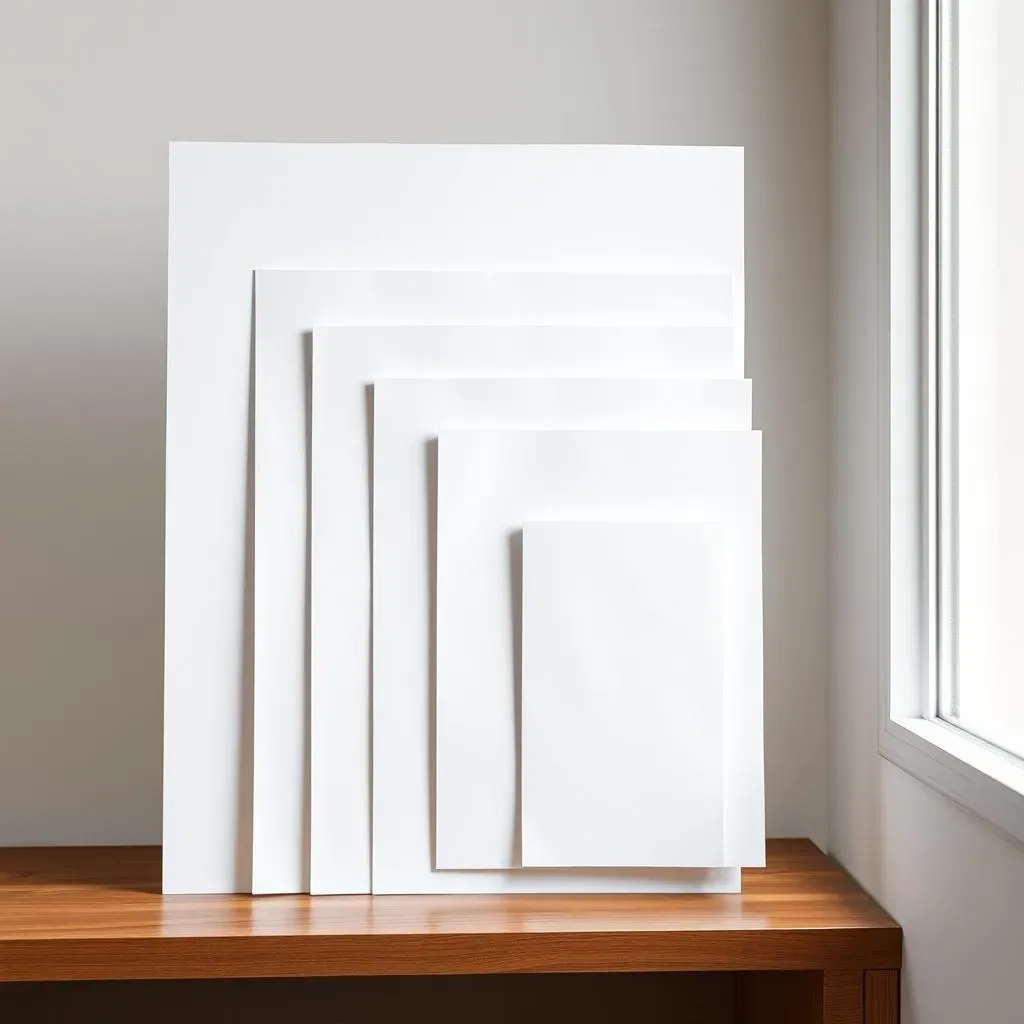Table of Contents
Ever wondered about the mysterious world of paper cut sizes? From the ubiquitous A4 to the less-familiar legal size, understanding paper dimensions is crucial for countless projects, from crafting and printing to design and office work. This comprehensive guide will demystify "paper cut sizes," providing a clear and insightful journey through the various standards and specialized formats used worldwide. We'll explore the internationally recognized ISO paper sizes, delving into the logic behind the A, B, and C series. Beyond the standards, we'll uncover the unique regional variations, including American, Japanese, and Chinese sizes. Learn how to navigate the diverse landscape of paper dimensions, from the common letter and legal sizes to the specialized formats used in photography, business cards, and more. By the end of this article, you'll be equipped to confidently choose the perfect paper size for any task, ensuring your projects are precisely sized and flawlessly executed. Let's dive in and unravel the secrets of paper cut sizes!
Standard Paper Sizes: A Global Overview
Standard Paper Sizes: A Global Overview
The ISO 216 Standard: A Global Harmony
Let's start with the foundation: ISO 216. This international standard defines the A series of paper sizes, a system based on a simple yet elegant principle: each size is exactly half the area of the next larger size. Think of it like a set of perfectly nested Russian dolls, but for paper! This means an A4 sheet is half the size of an A3, and an A5 is half the size of an A4, and so on. This consistent ratio makes scaling and printing incredibly easy. Imagine trying to print a document designed for A4 on a printer that only supports letter size—a nightmare! But with the ISO standard, it’s a breeze.
The most common size in this series is, of course, A4. It's the workhorse of the paper world, used everywhere from offices to homes. But the beauty of the ISO system lies in its scalability. Need a bigger poster? Use A3. A smaller flyer? A5 is perfect. Need to cut paper to size? Check out our guide on cutting guides to get it just right.
Paper Size | Dimensions (mm) | Approximate Dimensions (inches) |
|---|---|---|
A0 | 841 x 1189 | 33.1 x 46.8 |
A1 | 594 x 841 | 23.4 x 33.1 |
A2 | 420 x 594 | 16.5 x 23.4 |
A3 | 297 x 420 | 11.7 x 16.5 |
A4 | 210 x 297 | 8.3 x 11.7 |
Beyond A Series: B and C Sizes
While the A series reigns supreme, there are other players in the paper size game. The B series shares the same aspect ratio as the A series but offers slightly larger sheets. This makes them ideal for posters, blueprints, or other projects where a bit of extra space comes in handy. Imagine designing a stunning piece of paper cutting art; the B series provides the perfect canvas for larger, more intricate designs.
And then there's the C series, mostly used for envelopes. It's cleverly designed so that an A4 sheet fits perfectly inside a C4 envelope, and an A5 sheet fits snugly into a C5 envelope, and so on. This is a perfect example of thoughtful standardization. It ensures that your letters arrive safely and neatly in their intended envelopes. Ever wondered what to do with those pesky paper cuts? Well, we've got a comprehensive guide on paper cuts to help you out!
- A Series: Commonly used for documents and printing.
- B Series: Larger format, suitable for posters and blueprints.
- C Series: Primarily used for envelopes.
Regional Variations: A World of Paper Sizes
While the ISO standard has brought a degree of global harmony to paper sizes, regional variations still exist. In North America, for instance, the "letter" (8.5 x 11 inches) and "legal" (8.5 x 14 inches) sizes are widely used. These sizes, while not directly part of the ISO system, have their own unique place in the world of paper. These differences can be a bit of a head-scratcher for international collaborations, but understanding these variations is crucial for seamless communication and project execution.
Other regions have their own unique traditions and standards. Knowing these variations is key to avoiding costly mistakes. For example, if you're designing marketing materials for international distribution, you need to ensure your designs are compatible with the local paper sizes. Otherwise, you might find yourself with posters that are too big or too small for their intended purpose. To avoid this, be sure to check the local standard before beginning any project. Learn more about the tools you'll need for the perfect cut with our guide to essential paper cutting tools.
"The beauty of paper is in its versatility, its ability to transform into countless forms, from intricate designs to simple everyday documents. Understanding the nuances of paper sizes is the first step toward unlocking its full potential." - Anonymous Paper Enthusiast
Specialized Paper Sizes: Beyond the Basics
Specialized Paper Sizes: Beyond the Basics
Beyond the Standard: Specialized Paper Sizes
Okay, so we've covered the usual suspects—the A, B, and C series, and the North American standards. But the world of paper sizes is far more diverse than that! Think about envelopes—there are countless sizes beyond the standard C series, catering to everything from postcards to bulky packages. And don't forget about those fun, quirky sizes like the Demy (15 x 20 inches), which has a history dating back to the days of letterpress printing. It's like discovering a hidden world of paper!
Then there are the sizes specifically designed for particular uses. Consider photographic paper, which comes in a variety of sizes optimized for different print formats. You'll find sizes perfectly matched to standard frame sizes, or even custom sizes for unique artistic projects. And let's not forget about index cards, business cards, and even newspaper sizes—each with their own unique dimensions and purposes. Need help choosing the right paper for your project? Check out our guide on choosing the right paper.
Paper Type | Common Sizes (Examples) | Typical Use |
|---|---|---|
Photographic Paper | 4x6, 5x7, 8x10 inches | Prints, photos |
Index Cards | 3x5, 4x6 inches | Note-taking, indexing |
Business Cards | 2x3.5 inches (standard) | Professional networking |
It’s amazing how many different paper sizes exist, right? Each size serves a specific purpose, reflecting the diverse needs of different industries and creative endeavors. For example, architects use specialized paper sizes for blueprints, ensuring that details remain clear and legible at the necessary scale. This precision is essential for their work, and the paper size plays a critical role in achieving it. Similarly, artists often select paper based on texture, weight, and size to create the desired visual impact. The paper becomes an integral part of the artwork itself.
Sometimes, you might even encounter custom-cut paper sizes. These are often used for specialty items like invitations, packaging, or unique art projects. The possibilities are endless! If you’re looking to create something truly unique, don't be afraid to explore custom cutting. You can get your paper cut to your exact specifications, giving you complete control over the final product. Remember to consider your paper cutting tools carefully—check out our guide on essential tools for a perfect cut.
- Envelopes: Numerous sizes to accommodate various letter and package sizes.
- Photographic Paper: Sizes optimized for standard print and frame sizes.
- Index Cards: Standard sizes for note-taking and organization.
- Custom-Cut Paper: Tailored to specific project needs.
Choosing the Right Paper Size for Your Project
Choosing the Right Paper Size for Your Project
Matching Paper to Purpose
So, you've got a project in mind—maybe it's a stunning piece of paper-cutting art, a professional presentation, or simply printing some family photos. The first step? Choosing the right paper size! This isn't just about aesthetics; the right size ensures your project looks its best and functions as intended. A tiny photo on a huge sheet of paper looks silly, right? Similarly, trying to cram a complex design onto a postage stamp-sized piece of paper will be frustrating. Picking the correct size is about striking a balance between visual impact and practicality.
Consider your project's purpose. Are you creating a large-scale poster for a conference? Then a B-series or even a custom-cut size might be your best bet. If you're printing a simple letter, A4 or letter size is perfectly adequate. For intricate paper-cutting designs, the size will depend on the complexity of the design and the tools you'll be using. A smaller design might work well on A5 paper, while a larger, more complex design might require a bigger sheet. Need help with choosing the right paper for your project? Our guide on choosing the right paper can help.
- Consider the project's purpose (poster, letter, art, etc.)
- Think about the design's complexity and scale.
- Factor in the tools and techniques you'll be using.
Let's say you're designing a business card. You'll want to stick to the standard business card size to ensure compatibility with common card holders and printing services. Trying to use a non-standard size could lead to problems with printing and handling. A similar principle applies to envelopes; using a non-standard size might mean your mail doesn't fit correctly or gets lost in the postal system. It's all about finding that sweet spot between creativity and practicality.
Remember, you can always cut down larger sheets to create smaller pieces, but you can't magically make a small sheet bigger. So, it's often best to start with a size that's slightly larger than you think you'll need, leaving room for adjustments and mistakes. This approach gives you more flexibility during the project and reduces the risk of running out of space. It also allows for experimentation and creative exploration without the limitations of a small piece of paper. If you're working on a intricate paper cutting project, ensure you have the right tools. Our guide to essential paper cutting tools will help you choose the right ones.
Project Type | Recommended Paper Size | Reasoning |
|---|---|---|
Business Card | Standard Business Card Size | Compatibility with holders and printers |
Letter | A4 or Letter Size | Standard and widely accepted |
Poster | B-Series or Custom | Large format, high visual impact |